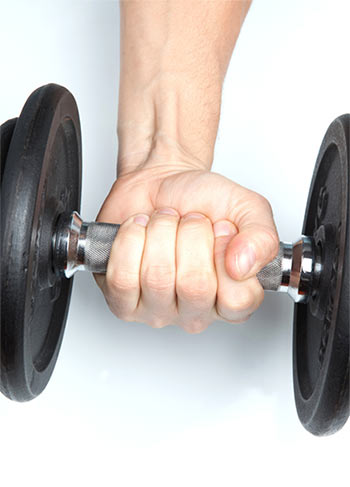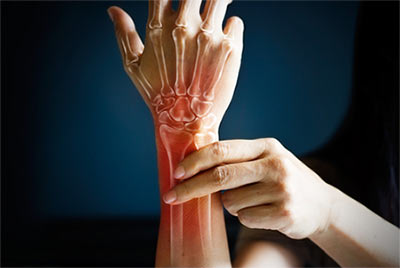
While you might never think about training them, your wrists do far more than you might think. These overlooked joints perform an unbelievable amount of work, and they’re often at risk of injury, so why aren’t you training them?
Today we’re going to look at how the wrist works, why you should care, and how you can protect and strengthen your most over-worked, under-loved joints!
The Wrist and Context – Forgotten Joints
The problem with the wrists is that they need to be trained and considered in the same way as other areas, like the hips or shoulders. However, most people don’t give them attention until they start hurting.
We see tons of wrist-related pain, related to compression during exercise, repetitive strain during work, or even just falling on an outstretched hand. There are common wrist injuries that could have been prevented or managed with a thoughtful approach to wrist training and care.
For example, as one of the most used but least trained joints in the body, wrists have an imbalance of work-done to preparation performed. Issues like carpal tunnel are common, while generic wrist pain and difficulty in loading effectively at non-medical levels also affect many people.
Wrist health is one of the areas where we want to invest time and effort, on both the mobility and strength of the structure. This means the muscles of the forearms specifically, since these control the wrists.
This is even more important in our modern day environments. Many manual and desk jobs involve a significant amount of repetitive wrist strain, but without the physiotherapy and preparation associated with other joints.
Even a few kilos here and there through work are shown to be a significant factor in injuries and repetitive strain issues. Pain is common and persistent, and often develops chronically, lasting months or years.

The Physical Characteristics
So, what’s up with the wrists?
Firstly, they’re a small joint. They are considerably smaller than many of the more ‘significant’ joints that get more attention in workout programs. The muscles that control them are also smaller and there are lots of them, which leaves a lot of movements neglected when it comes to strength and control.
Think about this … would you even know, or notice, if you had tight forearms?
They’re also very rich in connective tissues and contain many small bones. They’re complicated, and things can easily go wrong if they’re not well-maintained. This could occur as pressure on the joint, as constriction of the nerve in the wrist, as in carpal tunnel, in degradation of tendons, or even in bone-on-bone friction.
The wrists also have a relatively large range of motion relative to their size and are often compressed, which combines with the many bones and overlooked status to produce a significant risk profile.
We might not train wrists often, but we always put demands on them. It’s for this reason that you need to be conscious of how you treat them, and be sure to give them the mobility and strength work they deserve.
Training and Protecting Your Wrists
The obvious antidote to these problems is prevention. The prevention of wrist issues is actually relatively easy once you start paying attention it. This is because the key practices for good wrist health are simple: regular movement, regular mobility, and regular strength training.
Regular Movement!
The first and most important consideration is to make sure you’re regularly moving your wrists through their full range of motion, not just the kinds used in desk work or your job.
Moving in all directions helps you to maintain the natural and healthy range of motion in the wrists. This isn’t always possible if you’ve got limited movement, but working through the full range that you can move through is going to help keep your wrists healthy.
This includes things like wrist circles and wrist ‘waves’, which can be performed regularly anywhere. These can be used at work, for example, helping to offset any work-related injury risks. These are just what the wrist is designed to do.

Regular Mobility and Stretching Exercises
If you’re experiencing limited mobility in the wrists, or any feeling of muscular tightness/pain, then a simple stretching routine can help.
Remember, the wrist itself might be all connective tissue and bone, but it’s connected to the muscles of the forearms. Excessive tightness in these muscles can easily cause discomfort and limit the safe and pain-free movement of the wrist joint.
Regularly stretching the wrist in the major movements, extension and flexion, are going to help reduce demands on the wrist and keep it pain-free in everyday life. These are simple little stretches you can perform anywhere, a few times a day, to help relieve any existing pressure or limitations.
The Best Way To Improve Wrist Mobility
This kind of simple stretching routine offers a great example of regular, routine wrist preparation. It focuses on stretching and controlling through the various ranges and angles that the wrists might be put in, ensuring you’re not missing anything important.

Light Exercise for Basic Health and Rehabilitation
Whoever you are, you can benefit from lightly exercising the wrists. They’re not difficult to train and for most people it’s a relatively small effort a few times a week.
This is a small commitment but is likely to help with long-term wrist strength and health. In much the same way as you want to stay active with the rest of your body, you should get a reasonable amount of wrist exercise in.
Initially, this might just be some wrist raises against a wall; a very light exercise that helps to strengthen the wrists in a number of positions. These can be gently progressed over time by increasing the amount of your bodyweight you’re putting into them.
Equally, a wrist curl with rotation can use something as light as canned goods or very light dumbbells. These are, again, very light and will suit a few sets every day or two, helping to build up strength and resilience in the wrists.
How To Stretch & Strengthen Your Wrists
Moderate Exercise for Athletes / Strength Lovers
If you’re an athlete or recreational gym-goer who is serious about strength and performance, the light exercise above won’t cut it. It’s a way of developing a simple wrist maintenance routine, but won’t be enough for maximiszng your grip strength and wrist health.
When performance is more important, and there’s more on the line, it’s worth putting more time, effort, and planning into your wrist training.
Wrist exercise make great accessories and end-of-session finishers. We like getting some simple rehab exercises in, even if it’s just 1-3 sets at the end of a workout while you’re packing away and getting ready to leave.
There are a few great examples of this kind of strength and stability training in the wrist that you should consider:

1.Push ups with a wrist raise: these are a great way of easing into wrist strength, as they use some momentum and don’t require a dead-start using the wrists.
2. Wrist curls: a classic, and they should be performed with both extension and flexion portions, helping to even out the development of your forearms.
3. Wrist rotations: easily super-set with wrist curls, this exercise can help to improve rotation in the wrists, which you may struggle to train otherwise.
4. Wrist deadlifts with kettlebells: these are a great exercise for serious strength in the wrists, though they’re both challenging and harder to recover from than others on this list. A good choice for accessory days/before rest days.
5. Banded wrist flexion: this is a simple and effective movement for warming up the wrists and building strength. They require very little time and equipment, but are a great staple.
This kind of work helps to build musculature in the forearms, strengthen the tendons in the wrist, and protect the whole structure from poor positioning and compressive forces. Weakness here can produce injury or poor technique in the gym, so it’s worth giving a little time to the wrists when possible.
Final Thoughts
The wrists aren’t given the credit they deserve, but they’re a fantastic structure to work on: you can produce some significant changes with very little effort.
Simply doing something about your wrists is a fantastic start and should be the baseline we’re all working on. Additional strength and effort is always available for those who have more serious demands on their wrists, and strength exercises are varied and cover all your bases.
You don’t need to spend hours strengthening your wrists every training session; you just need to make sure you’re incorporating some mobility work and moving the wrists in a deliberate way. Whether that’s light or heavy is all about what your goals are.
It doesn’t take a huge commitment, and practicing some wrist movement now might save you a ton of pain and discomfort down the road!







